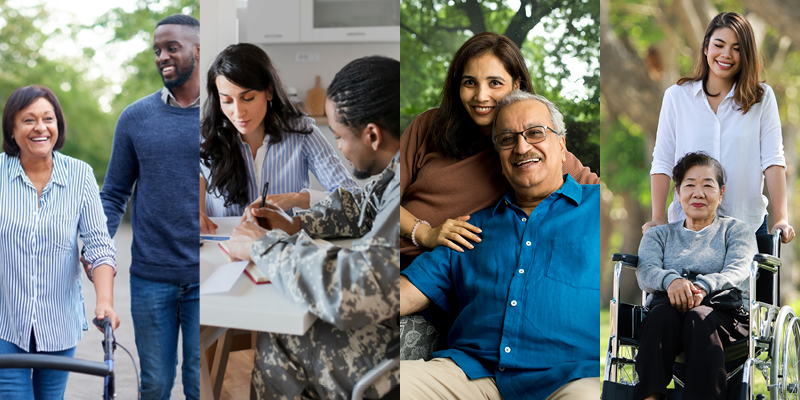
Our nation’s family caregivers are vital for the health and well-being of our communities. Caregivers, — about 1 in 5 adults in the U.S.— are advocates, care coordinators and overall supporters to the physical and emotional health of those for whom they care. Family caregivers represent all backgrounds and care for individuals with a wide range of needs, including older individuals, people with disabilities, military servicemembers and veterans.
Family caregivers need a support system that ensures they can balance their caregiving responsibilities and employment; about 60% of caregivers work. Many working family caregivers often need flexible work schedules to accommodate competing priorities.
For 30 years, the Family and Medical Leave Act (FMLA) has provided eligible workers with the right to take job-protected leave while continuing their health benefits, so they can care for a family member with serious health conditions or injuries. This includes using FMLA intermittently, as the need arises, or by reducing the employee’s usual weekly or daily work schedule so they can provide care.
For Kris Garcia from Denver, Colorado, these protections were invaluable: “When my mom was originally diagnosed with cancer, I used intermittent FMLA leave to take her to radiation appointments and oncology visits. Later, I used FMLA leave for meetings with the hospice team that helped me with her end-of-life care. Being by her side made a world of difference for both of us.”
While millions of caregivers have taken advantage of the FMLA’s protections, the Department of Labor estimates that many workers, particularly low wage workers and workers of color, don’t exercise their rights to FMLA leave. Many workers are unaware of FMLA protections, concerned with being treated differently at work, or cannot afford unpaid leave. Sadly, when workers forgo leave to care for a family member, treatment for the care recipient can be postponed or stopped altogether.
In recognition of the vital role of caregivers and as part of our ongoing efforts to empower workers to take FMLA leave, the Wage and Hour Division is launching a new webpage and updated resources to help workers seeking to take time off from work to care for a family member. This webpage includes a practical guide on how to talk to your employer about taking job-protected leave under the FMLA, and updated fact sheets on using FMLA leave when your family member has a serious health condition, because of a family member’s military service, or to care for an adult child with a disability. The new webpage also includes frequently asked questions on taking FMLA leave, and additional resources family caregivers may find helpful when navigating their caregiving responsibilities.
As part of our commitment to engage stakeholders in conversations on barriers to workplace leave, we’re hosting a virtual roundtable Feb. 23, “Working While Caring: A Discussion on Workplace Leave for Family Caregivers.” For this event, we’re joining the Women’s Bureau, Office of Disability Employment Policy, Veterans' Employment and Training Service, AARP, American Association of People with Disabilities, and Blue Star Families to discuss barriers to workplace leave for family caregivers.
Caregiving is expected to grow as the older adult population increases. The CDC estimates 20% of working-age adults will become caregivers by the year 2030. Our nation’s family caregivers deserve our recognition and respect. We are proud to enforce their right to take time to care when they need it.
Jessica Looman is the principal deputy administrator for the Department of Labor's Wage and Hour Division. Follow the division on Twitter at @WHD_DOL and LinkedIn.
Licencia Familiar y Médica: Protegiendo a los Cuidadores
 Los cuidadores familiares son vitales para la salud y el bienestar de nuestras comunidades. Los cuidadores, aproximadamente 1 de cada 5 adultos en EE.UU., son defensores, coordinadores de atención y protectores generales de la salud física y emocional de aquellos a quienes atienden. Los cuidadores familiares representan todos los orígenes y cuidan a personas con una amplia gama de necesidades, incluidas personas mayores, personas con discapacidades, miembros del servicio militar y veteranos.
Los cuidadores familiares son vitales para la salud y el bienestar de nuestras comunidades. Los cuidadores, aproximadamente 1 de cada 5 adultos en EE.UU., son defensores, coordinadores de atención y protectores generales de la salud física y emocional de aquellos a quienes atienden. Los cuidadores familiares representan todos los orígenes y cuidan a personas con una amplia gama de necesidades, incluidas personas mayores, personas con discapacidades, miembros del servicio militar y veteranos.
Los cuidadores familiares necesitan un sistema de apoyo para poder compaginar sus responsabilidades de atención y sus necesidades de empleo. Aproximadamente el 60% de los cuidadores trabajan. Muchos a menudo necesitan horarios de trabajo flexibles para poder equilibrar ambas prioridades.
Por 30 años ya, la Ley de Ausencia Familiar y Médica (FMLA) ha ofrecido a trabajadores elegibles el derecho a tomar una licencia con protección laboral y continuación de beneficios de salud para poder atender a un miembro de la familia que adolece de una enfermedad o lesión grave. Este derecho incluye el uso intermitente de la licencia FMLA, caso necesario, o una reducción del horario habitual del empleado para que pueda dar la atención necesaria.
Para Kris García de Denver, Colorado, estas protecciones tuvieron un valor incalculable: “Cuando a mi mamá le diagnosticaron cáncer, usé la licencia FMLA intermitente para llevarla a citas de radiación y visitas de oncología. Mas adelante usé la licencia FMLA para poder atender reuniones con el equipo de hospicio que me ayudó con sus cuidados finales. Estar juntos en esos momentos fue fundamental para los dos”.
Si bien millones de cuidadores han tomado ventaja de las protecciones que ofrece la FMLA, el Departamento de Trabajo estima que muchos trabajadores, particularmente de bajos ingresos y de comunidades minoritarias, no ejercen estos derechos. Muchos ni siquiera saben de estas protecciones, les preocupa que les puedan tratar diferente en el trabajo caso de que usen este derecho, o piensan que no pueden permitirse una licencia sin sueldo. Lamentablemente, cuando un trabajador no toma la licencia para cuidar a un familiar, el tratamiento de la persona que requiere cuidados puede posponerse o detenerse por completo.
En reconocimiento al papel vital de los cuidadores y como parte de nuestros esfuerzos continuos para empoderar a los trabajadores para que tomen licencia FMLA, la División de Horas y Salarios está lanzando una nueva página por Internet, así como recursos actualizados para ayudar a los trabajadores que buscan tomarse tiempo de trabajo para cuidar a un miembro de la familia. La página incluye una guía practica de cómo hablar con su empleador para tomar una licencia laboral protegida bajo la FMLA, y hojas informativas actualizadas sobre el uso de la licencia FMLA cuando su familiar tiene una condición de salud grave, por el servicio militar de un familiar o para cuidar a un hijo adulto con una discapacidad. La nueva página también incluye preguntas frecuentes y recursos adicionales que los cuidadores familiares pueden encontrar útiles respecto a sus responsabilidades.
Como parte de nuestro compromiso por involucrar a todos los interesados en temas relativos a barreras para obtener permisos laborales, el 23 de febrero organizaremos el conversatorio virtual “Trabajar mientras cuidas: Una Charla sobre Licencia Laboral para Cuidadores Familiares”. Para este evento nos uniremos a la Oficina de la Mujer, la Oficina de Políticas de Empleo para Personas con Discapacidades, el Servicio de Capacitación y Empleo para Veteranos, la AARP, la Asociación Americana de Personas con Discapacidades y Blue Star Families.
Se estima que las necesidades de cuidado aumenten a medida que lo hace la población de adultos mayores. Los CDC prevén que el 20% de los adultos en edad laboral serán cuidadores llegado el 2030. Los cuidadores familiares de nuestra nación merecen nuestro reconocimiento y respeto. Estamos orgullosos de hacer cumplir su derecho a tomarse tiempo cuando lo necesitan.
Jessica Looman es la administradora principal adjunta de la División de Horas y Salarios del Departamento de Trabajo. Siga a la división en Twitter por @WHD_DOL y por LinkedIn.

 U.S. Department of Labor Blog
U.S. Department of Labor Blog



